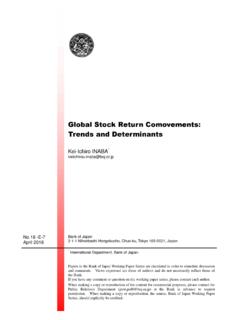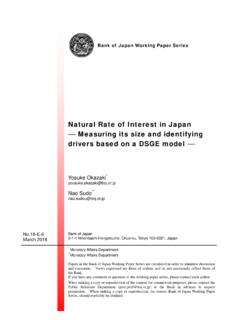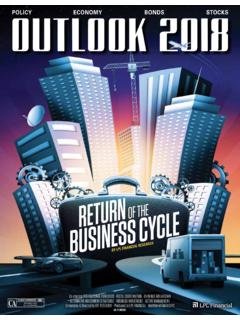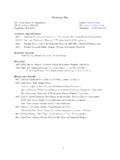Transcription of Quantitative and Qualitative Monetary Easing: …
1 Quantitative and Qualitative Monetary easing : theory and Practice Speech at the Foreign Correspondents' Club of Japan B a n k o f J a p a n M a r c h 20, 2 015 Haruhiko Kuroda Governor of the Bank of Japan 1 Introduction It is my great honor to have the opportunity to speak today at the Foreign Correspondents' Club of Japan. With the European Central Bank (ECB) having started its asset purchase program, most of the major central banks, including the Federal Reserve and the Bank of England (BOE), now have adopted Quantitative easing (QE). If I may borrow the words of Professor Takatoshi Ito, a friend and someone I greatly respect, "we are all QE-sians now.
2 " That being said, the economic and price situation against which QE has been introduced, as well as the policy transmission mechanism assumed, differ among countries and regions. Today, I would like to clarify the characteristics of the Bank of Japan's current Quantitative and Qualitative Monetary easing (QQE) by focusing on similarities to and differences with the QE introduced by other central banks. I will further explain how QQE has been producing the intended effects. I. The theory behind QQE Similarities and Differences between QE and QQE I just mentioned that "we are all QE-sians now." What brought us into this situation is the global financial crisis in 2008.
3 The and European economies deteriorated considerably due to the global financial crisis and unemployment increased substantially, so that central banks had to stimulate the economy through Monetary easing . Initially, central banks in Europe and the United States responded to the crisis by using the traditional policy tool of lowering short-term interest rates, but since the economies deteriorated quite significantly, those rates soon approached the zero lower bound (Chart 1). Facing the zero lower bound on short-term nominal interest rates, central banks were therefore confronted with the question of how to proceed with further Monetary easing .
4 The Federal Reserve's and the BOE's answer was to introduce QE. QE mainly aims at stimulating the economy by lowering long-term interest rates, which still had room to fall, through massive purchases of government and other bonds by the central bank. The Bank's QQE is similar to QE in that it aims to encourage long-term interest rates to decline through massive purchases of government bonds. QQE, however, has another 2 element: to drastically change the deflationary mindset that had taken hold amid the prolonged deflation. In order to understand this point, it is necessary to correctly diagnose the problems ailing Japan's economy and identify appropriate remedies.
5 Japan's economy had been suffering from deflation since the mid-1990s, with the year-on-year rate of change in the consumer price index (CPI) being about zero or slightly negative. A key feature of deflation in Japan was that it was mild but persistent: the average of the year-on-year rates of change in the CPI from fiscal 1998 to fiscal 2012 was only minus percent, but the deflationary situation lasted for a decade and a half (Chart 2). Japan got mired in deflation due to a variety of factors, including balance sheet adjustments by firms and financial institutions following the bursting of the asset price bubble, the inflow of low-priced goods from emerging economies, and the excessive appreciation of the yen.
6 Whatever the reasons may be, a key problem that arose is that, as prices continued to fall due to these factors for a prolonged period, a deflationary mindset took hold among the public -- that is, the belief became entrenched that prices would not increase but continue to steadily decline. Once this deflationary mindset had taken hold, people engaged in economic activity assuming that deflation would continue. As a result, the economy fell into a vicious cycle of a decline in prices, a decline in sales and profits, stagnant wages and consumption, and a further decline in prices. Moreover, under deflation, the real value of cash and deposits increases with the decline in prices.
7 Therefore, hoarding cash and deposits becomes a relatively better investment strategy than actual investment, discouraging firms from taking risks and investing in business facilities and in research and development to launch new businesses. In this way, deflation in Japan perpetuated itself in a self-fulfilling manner and the growth potential continued to decline. In order to overcome this situation, it is necessary to change the entrenched view that "prices will not rise" and achieve a state in which firms and households act based on the assumption that "prices will rise moderately every year." In the economic jargon, people's view on how prices will develop in the future is called inflation expectations.
8 And although inflation rates tend to fluctuate -- reflecting not only the business cycle but also temporary factors such as changes in commodity prices -- they are likely to do so at around 3 the level of inflation expectations on average, if medium- to long-term inflation expectations are anchored at a certain level. A numerical definition of what central banks consider as price stability based on a specific price index is about 2 percent in terms of the year-on-year rate of change in the CPI; this has become the global standard in recent years. While I will not go into detail due to time constraints, this figure -- 2 percent -- takes into account the upward bias in the CPI, that is, the tendency of the index to overstate inflation, and provides a buffer allowing to sufficiently lower real interest rates should the economy deteriorate.
9 For Japan's economy to overcome deflation, it was necessary to dispel the deflationary mindset and raise inflation expectations -- which had declined to about 0 percent -- to about 2 percent and re-anchor expectations at that level. Changing people's expectations is the main aim of QQE. The theory behind QQE Attempting to change people's mindset and perceptions through Monetary policy is not without historical precedent. For example, while the direction of desired change was the opposite of that in Japan, the Federal Reserve under Chairman Paul Volcker was successful in the late 1970s to early 1980s in substantially lowering inflation expectations, which had been ratcheting upward, through powerful Monetary tightening (Chart 3).
10 Since both unemployment and inflation were surging at the time, such stringent Monetary tightening created both political and social challenges. Despite such difficulties, however, it was quite clear to Chairman Volcker what policy steps he had to take to lower inflation expectations: he had to pursue strong Monetary tightening by substantially raising short-term interest rates to contain inflation. On the other hand, while QQE would not aggravate unemployment, it faced another problem, namely that the tools for Monetary easing were limited, given that short-term interest rates were close to the zero lower bound.















